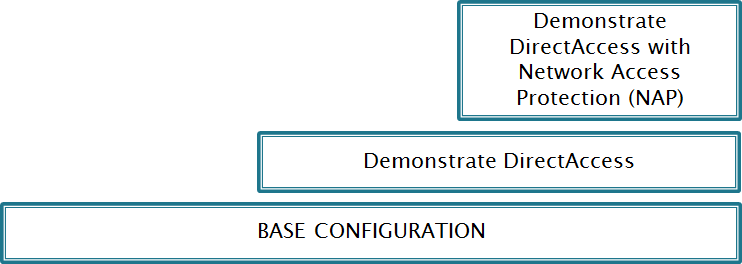Contributing to TLGs Part 1: Writing your own modular TLG
One of the cool things about Test Lab Guides (TLGs) is that they are not a closed platform, exclusive to Microsoft writers. With the TechNet Wiki, anyone can create and publish his or her own TLG content.
In this multi-part blog series, I will describe how you can easily contribute your own TLG content.
Part 1: Writing your own modular TLG
Modular TLGs describe how to set up and demonstrate a technology, product, or scenario for either the Base Configuration test lab or a test lab based on an existing modular TLG. The following figure shows where modular TLGs go.

The Demonstrate A modular TLG starts with the Base Configuration test lab environment. The Demonstrate A with B modular TLG starts with the test lab environment of the Demonstrate A TLG.
For example, the Test Lab Guide: Demonstrate DirectAccess describes how to configure and demonstrate the DirectAccess functionality using the Base Configuration test lab as its starting point. As another example, the Test Lab Guide: Demonstrate DirectAccess with Network Access Protection (NAP) describes how to configure and demonstrate NAP enforcement for DirectAccess connections using the DirectAccess test lab as its starting point.
The following figure shows this relationship.

The following is the basic process for publishing your own modular TLG.
1. New stack or build a stack?
Modular TLGs are designed to stack on each other to build out more complicated multi-technology or multi-product scenarios. These stacks can be used as a proof-of-concept to demonstrate the intended functionality as part of the IT evaluation process.
So the question becomes: Do you want to create a new stack (a modular TLG based on the Base Configuration test lab) or add to a stack (a modular TLG based on an existing TLG)?
2. Create the content and publish
The next step is to begin planning the overall structure of your modular TLG. To help with this, use the Modular Test Lab Guide Template in the TechNet Wiki as a starting point. If you use this template, your modular TLG will have the same structure and boilerplate text as all other TLGs, allowing the readers of your modular TLG to configure more quickly a test lab based on your instructions.
After documenting the steps and verifying that they work, publish the entire TLG as a single topic in the TechNet Wiki.
3. Tell the world
To make sure that others in the community know about your new modular TLG, do the following:
- Update the Test Lab Guides TechNet Wiki topic with a link to your new modular TLG
- Send a quick email to tlgfb@microsoft.com. Tom Shinder or I will announce your new modular TLG in the Test Lab Guides blog, in Twitter, and on Facebook.
- Advertise your new creation using your own social media outlets
That’s pretty much it. Right now, there are plenty of opportunities to develop this content and share it with the world.
Write on!
Joe Davies
Principal Writer
Windows Server Information Experience (WS iX)